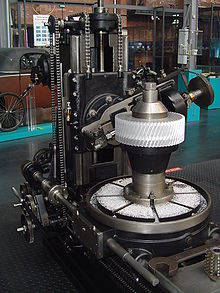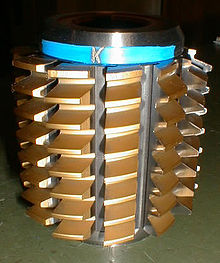Hobbing
Hobbing , as a sub-area of milling, is a manufacturing process for gear pre-machining and finishing for gears .
history
Hobbing was invented by Christian Schiele in 1856 , but at that time it was not yet able to implement the process in suitable machines. In 1887, the first gear hobbing machines were built based on a patent from George B. Grant , and the process did not establish itself until 1897 after Robert Hermann Pfauter in Chemnitz applied for a patent for a universal gear hobbing machine.
Procedure
Hobbing is one of the continuously working gear cutting processes and is very flexible and highly productive. The milling cutter rotation generates the actual cutting movement. With a hob, all numbers of teeth, all profile shifts and any helix angles can be generated by varying the machine positions. There is generally only a limitation due to the working range of the machine tool .
The hob is geometrically a single or multi-start worm with flutes and forms a worm gear with the workpiece to be toothed . In addition to the rotation, the hob moves parallel to the axis of the workpiece along the workpiece in order to create the tooth gaps.
The teeth of the hob wear out from machining . Therefore, the hob is shifted tangentially to the workpiece (shifting) continuously or at certain time intervals in order to bring new teeth into mesh. If all teeth are worn over the entire length of the hob, the tool is exchanged and sharpened on a hob grinding machine.
The following types of gears can be produced by hobbing:
- External spur gears
- External helical gears
- Internal helical gears (with large internal diameters)
- Bevel gears with straight or curved teeth (spiral teeth)
- Crown wheels
- Hypoid -Verzahnungen (axes do not intersect)
- palloid -Verzahnungen
- Klingelnberg and Gleason gears
- Helical gears (helical worms and helical gears)
Small internal gears cannot be produced by hobbing; With these, the teeth are " pushed " (process: gear shaping ).
Advantages of hobbing over other gear cutting processes
- Versatility (any tooth shapes, splines, sprocket teeth, ratchet wheels, etc.)
- any helix angle possible
- any tooth widths possible
- uninterrupted machining without return strokes
- the machining takes place with a large number of cutting edges
- favorable balance of forces and high accuracy thanks to continuous machining
- easy production of tools
- easy tool setting on the machine
In the case of high-precision gears, the tooth flanks are produced by milling and, after hardening, are ground, scraped or honed (process: gear honing ).
literature
- Hermann Pfauter machine tool factory, Ludwigsburg (ed.): Pfauter hobbing part 1 . 2nd Edition. Springer Verlag, Berlin 1976, ISBN 3-540-07446-5 .
- Liebherr Verzahntechnik GmbH, Kempten (Hrsg.): Gear technology information for practice . August 2004, ISBN 3-00-012480-2 .
- Samputensili GmbH, Chemnitz (ed.): Gear Hobbing . December 2004




